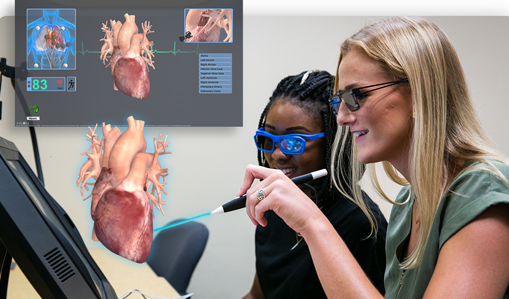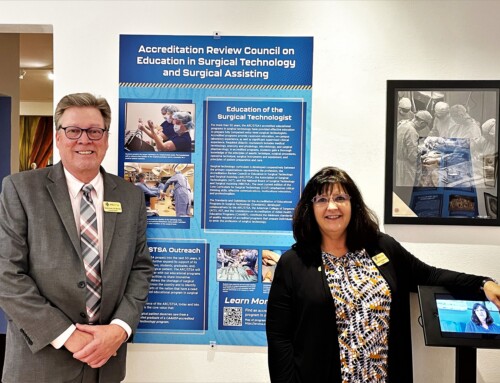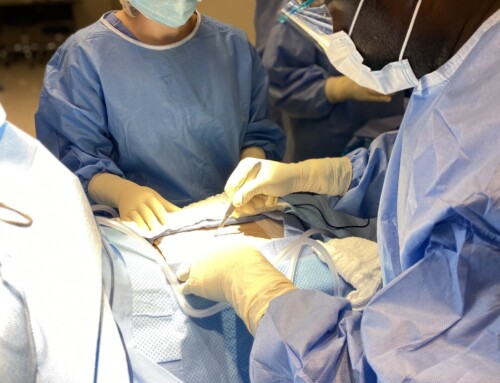Featuring Katie Towler, EdS, MA, and Niki Coughlin, BS, RCS, RVS, from Sioux City Career Academy, Sioux City, Iowa.
The heart is one of the most complex and vital organs within the human body. However, studying the heart can be challenging because of its intricacy, and not all institutions have access to a cadaver lab and human organs on campus. How can students get a look inside the heart to gain a true understanding of its extensive anatomy and physiology, and lay a solid foundation of knowledge for their future in the OR?
Katie Towler, principal of the Sioux City Career Academy (SCCA), and Niki Coughlin, a Human Body Systems teacher at SCCA, shared how using zSpace, an innovative learning tool that combines elements of augmented reality and virtual reality (AR/VR), has made a significant impact in helping their high school students learn about the human heart and body, as well as increasing student engagement through fearless learning.
“We were really excited to bring zSpace into our health science lab,” Towler said. “Looking at anatomy in a textbook is flat and static. Being able to manipulate what is happening and see the result is impressive and realistic.”
zSpace, deployed by Riverside Technologies, Inc. (RTI), allows students to conduct dissections of the heart and see structures of the heart that can’t be portrayed very well in 2D. Coughlin said that when her students are studying the heart using ZSpace, they can truly visualize the complexities of the human heart. “They are able to focus on the valves’ morphology, the chordae tendineae and how they are attached, and the papillary muscles.”
 zSpace allows students to conduct dissections and manipulate structures of the heart in a 3-D “screen-breaking” experience using deployed by Riverside Technologies, Inc. Check out these short videos of students exploring the heart: https://www.youtube.com/watch?v=6njC10TRukI and https://www.youtube.com/watch?v=YHLFEH9oaFQ
zSpace allows students to conduct dissections and manipulate structures of the heart in a 3-D “screen-breaking” experience using deployed by Riverside Technologies, Inc. Check out these short videos of students exploring the heart: https://www.youtube.com/watch?v=6njC10TRukI and https://www.youtube.com/watch?v=YHLFEH9oaFQ
Towler noted that zSpace has made a big difference in how students perform dissections and has also expanded opportunities for students beyond what they could do with consumable organs and materials.
Towler explained that a student can only dissect cadaveric tissue one time, and it’s easy to accidentally make an incorrect cut or cut too deep. “The beauty of virtual reality is that students can undo something,” Towler said. “They can see what goes wrong, go back, and redo it in a way that doesn’t waste a consumable supply.”
Towler shared that zSpace has significantly increased student engagement. zSpace isn’t just integrated into classrooms; it’s also embedded into the curriculum and provides an engaging, tactile way for students to interact with the concepts and standards to enhance their understanding. Teachers are able to show body systems in detail, rather than just talk about them. Students can immerse themselves into these body systems, rather than just sitting and listening or taking notes out of the textbook. Having students engage with the technology in this way and then apply what they are learning leads to better information retention and recall.
Towler also emphasizes how zSpace has opened the door to allow many more students to see the lab experience. “It’s allowed us to access samples and content that we couldn’t find otherwise,” Towler said. “We have this technology at our fingertips to manipulate and use whenever we can. It saves us from getting on a bus and going somewhere. Plus, it supports our standards and our content. All our lesson plans are already connected within that software. If a teacher is trying to find something to support one of their lessons, they can search by standard and find that lesson. They don’t have to recreate something, which is such a time saver for our teachers.”
“What we look at all the time is accessibility,” Towler said. “When we can make internal systems visible for students, we’ve increased accessibility. So much of this type of learning happens at the post-secondary level – they can afford the bigger equipment and technology. The beauty of offering this in high school is we can help them explore whether or not they are interested in a specific subject or career by looking at things that most students don’t see until they are in college.”
The students’ solid foundation of knowledge in anatomy and physiology leads directly to future success. Through a partnership with the Western Iowa Tech Community College (WITCC) surgical technology program, SCCA students have the opportunity to complete dual credits that transfer into the surgical technology associate degree program at WITCC. Students begin earning dual credit their freshman year of high school, and by their senior year can move directly into surgical technology courses. WITCC Program Director Renee Nemitz, CST, RN, FAST, shared details on this long-standing community partnership. “The students from SCCA are excellent and a huge boost to our program. The students’ foundation laid at SCCA, particularly their knowledge of anatomy and physiology, sets students on a solid pathway to achieving their goals and preparing for their future career as surgical technologists.”
Expanding students’ knowledge to prepare them for a career in health care is at the heart of the partnership between SCCA, ZSpace, RTI and WITCC. “Our mission is to ensure that every student has a plan for their future,” Towler said. “No matter which path they take; we just want them to be prepared for it.”
Disclaimer: The resources in this article are shared for informational purposes and not intended as a promotion or product endorsement by the ARC/STSA.
Join the next Better Together Success Strategy Talk on February 24 when our educators share how their community partnerships, including relationships between high schools and colleges, have increased student recruitment and retention. Click here to register.
Katie Towler, EdS, MA, (left), worked as a school counselor before continuing her education and receiving her educational specialist degree in administration. After working as an assistant principal and head principal at West Middle School in Sioux City, she became the first principal of the Sioux City Career Academy, which integrates core academic knowledge with technical and occupational knowledge to provide students with a pathway to post-secondary education and careers.
Niki Coughlin, BS, RCS, RVS, (right), has been a board-certified Cardiovascular Technologist for more than 20 years at MercyOne Sioux City, where she became the first cross-trained technologist (board certified in both vascular and cardiac sonography) in Sioux City. Currently, Niki is the Multi-Occupations Coordinator and teaches biomedical science at the Sioux City Career Academy. During her time with MercyOne, she was taught and mentored by the top cardiologists and technologists in the state, which fostered her love of the profession and passion for learning; and, motivated her to become a teacher, so that she could share that same joy of learning and inspire a new generation of health professionals.





